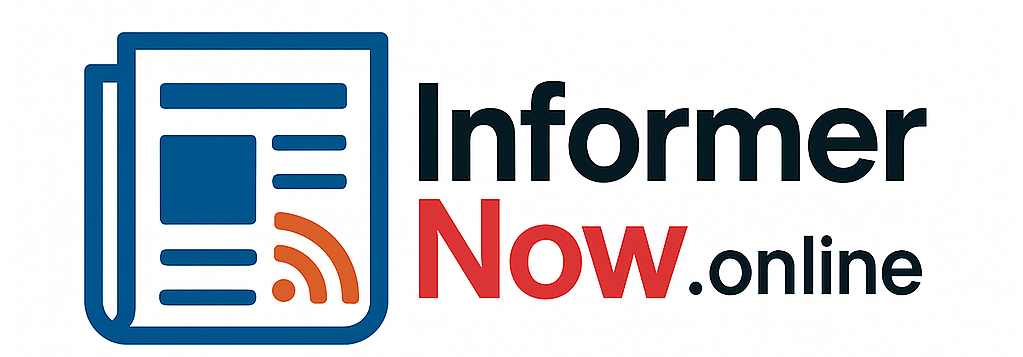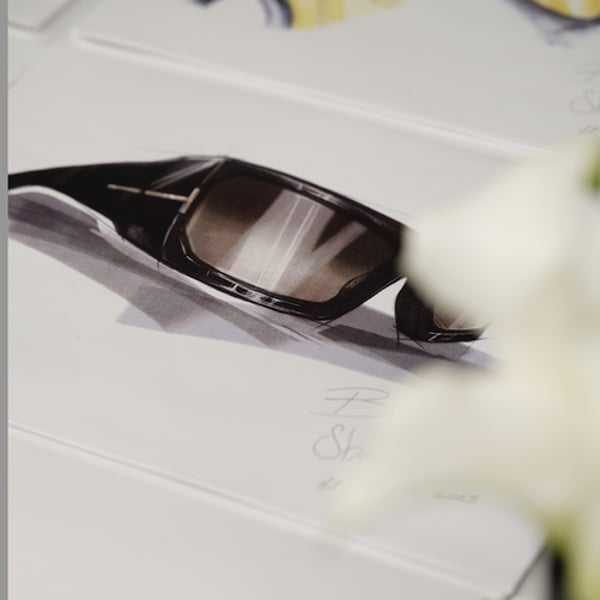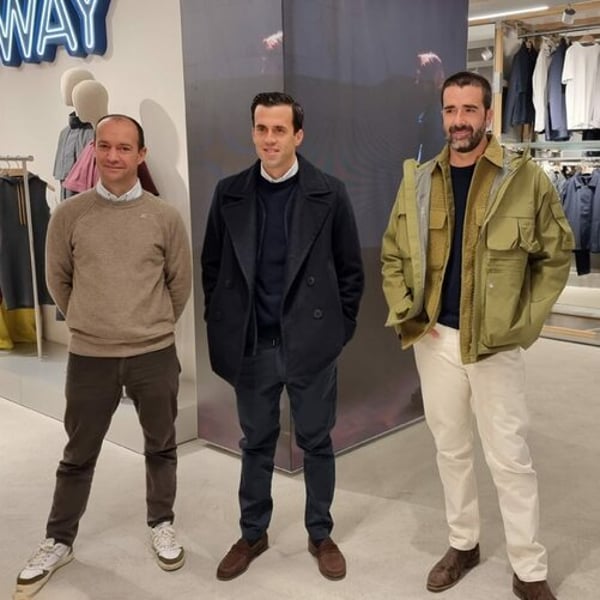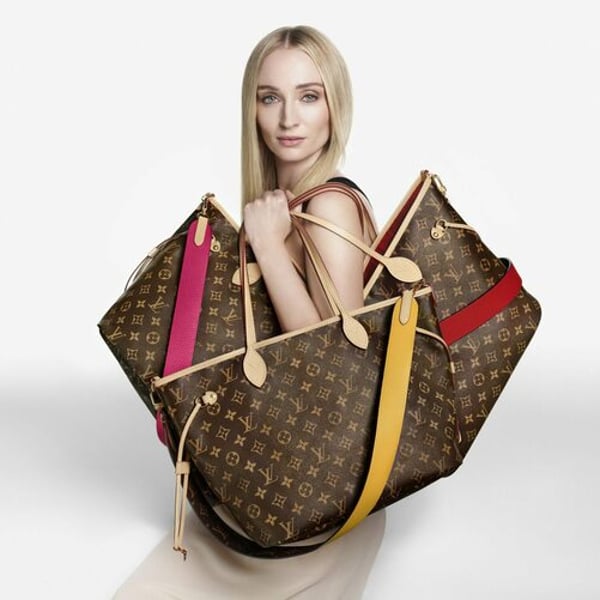Published
October 28, 2025
A modern, sleek “cocoon” in the heart of Saint-Germain-des-Prés, celebrating a story that began in 1853. In mid-October, Aigle unveiled a new flagship concept at its historic Paris store. For the reopening, the space tips its hat to the new dog collection, spotlighted in the window display with a dedicated photo campaign.
It also showcases the stylistic evolution of its clothing collections – which account for almost three quarters of sales – with a focus on parkas and coats, while highlighting the footwear offer and, above all, boots, whose master bootmakers’ craftsmanship has remained at the heart of the brand’s story for 172 years.
The showcase also reflects the vision championed by Valérie Dassier, who has led the brand within the MF Brands Group for the past three years. A former IKKS executive and a marketing and e-commerce specialist who has also worked at Princesse Tam Tam, Comptoir des Cotonniers and Kenzo, she and her team have refined the brand’s positioning at the intersection of urban lifestyle and the outdoor.
FashionNetwork.com caught up with the managing director. Seated beneath the “rubber forest”, the key concept of her new flagship, she reflects on the work accomplished, her interest in running a mission-driven company with an industrial backbone, and her development plan for the coming years.

FashionNetwork.com: You joined Aigle three years ago. At that time, the brand was moving upmarket and had just become a mission-driven company. What have you implemented since then?
Valérie Dassier: When I arrived, the task was quite straightforward: to reconnect with the brand’s DNA. I fundamentally believe that a brand has its DNA from the moment it is created, and there’s no point trying to change it. And Aigle’s DNA is exceptional. With the management team, we worked on three pillars. First, we reaffirmed the brand’s origins – namely, that Aigle is an outdoor brand. We doubled down on the outdoor lifestyle. And this was all the more opportune given that, while the lifestyle market is struggling, the outdoor segment, conversely, is buoyant.
FNW: How did you go about it, especially as there is a lot of competition in this segment?
VD: The brand’s DNA is completely in tune with how consumers behave today. In a world concerned with what we will leave our children on this planet, Aigle, by being aligned with nature, resonates. Aigle is also a timeless brand. With a growing tendency to consume less, product timelessness is fundamental. Thirdly, Aigle has always sought a balance between style and function. Covid shifted the lines when we realised that ready-to-wear was no longer a basic necessity. Today, functional products carry added value. We remove the hesitation from the purchase because the product has a purpose, it’s timeless and it will last. These brand values resonate with changing consumption patterns. We needed to reclaim this territory. That required a strong marketing commitment, particularly to explain function. We unite style and function, with the ambition of offering the best product with the best balance of quality, style and price.
FNW: Precisely, that’s the marketing aspect. On the product side, what have you been working on?
VD: There has been a great deal of commitment to the collections and their balance, with the CSR dimension always at the core. We reworked the brand’s historic stylistic pillars, each with its own tones: Earth, and also Sea, dedicated to the ocean, which we had somewhat neglected, and finally a city lifestyle pillar. We also revisited our icons. We relaunched the T-Kit concept, for example, which was an incredible innovation in parka design. With their parka, customers can pair any inner layer. Above all, our teams have done a fantastic job ensuring the concept works worldwide, even though sizing differs between Asia and Europe.
And we put the spotlight back on boots, which we had perhaps slightly overlooked. This is fundamental. Right now, we’re sitting in our “rubber forest”. In a way, we’ve made the boot bar almost sacred, like the nave of a church. More broadly, we have rethought the point of sale, the customer relationship, our sales signature, our merchandising and the way we bring fashion back into our silhouettes by highlighting our products in the window and in-store. With this, we have a well-balanced commercial triangle – image, product and distribution – with the customer at the centre. And it worked.
FNW: After Covid, the apparel offering evolved considerably. Beyond the logo, silhouettes were redesigned…
VD: Absolutely. We’ve reworked construction and colours. We often convey function through materials, but also through details that address everyday needs and draw inspiration from nature. The teams always ask themselves two questions: “What do I need to go trekking? And how do I integrate details that will deliver versatility between the city and the great outdoors?”
Focus on fit
FNW: But this has meant an increase in prices. This change wasn’t necessarily understood, particularly with the collaboration with Études Studio. How did you go about convincing customers and distributors?
VD: Prices haven’t risen that much. I think it’s the technicality that restores value to the products. When we use Gore-Tex or our own MTD membrane, the price naturally increases compared with products that don’t incorporate these technologies. And if you compare Aigle’s prices with the market, we’re very well positioned, whether in terms of waterproofing, windproofing or protection from the cold.

When repositioning, our basic principle is to keep our existing customers and win new ones. The arrival of Études helped us a great deal. It enabled us to refine the quality of our colours and some of our fits. And it wasn’t so much the price as the change in fit that unsettled customers at the time. Our long-standing customers were also very function-oriented. That’s why we introduced certain fits to continue meeting the needs of our historic customer base, while retaining the innovation and modernity that Études brought to recruit new customers. The good news is that we’ve won back our former customers and we’re recruiting strongly. Today, over 50% of our in-store transactions are with new customers.
FNW: So Aigle is growing?
VD: We’re keeping a close eye on sales trends. We’re seeing 10% growth between 2022 and today. The brand posted 276 million euros in 2024, and we’re now approaching 300 million euros. Around half our business is in Asia, mainly in China – with a historic partnership with the Li-Ning Group – but also in Hong Kong and Japan. We have also opened in South Korea. The other half is generated in Europe, where we are recording double-digit growth, well ahead of the market. Digital accounts for 20% of our business. That’s good, but given my digital expertise, it will obviously be a development priority for the future. Overall, we’re in a position to achieve healthy growth in the market.
FNW: Your collaboration with Études Studio, which focused on the more specialised Aigle Experience line, has now come to an end. What did this experience bring to the brand on a creative level?
VD: I think it first and foremost brought intellectual stimulation. When people from outside the brand delve into the archives and propose a vision, it’s always fascinating. As we progressed, we asked them to focus on a capsule that gave them absolute stylistic freedom. And for the rest of the collection, we proposed fits better suited to our customers. This capsule sat at the very top of the pyramid. The design studio then translated the ideas of this “Ultimate Aigle” into products more appropriate for our global offer. In concrete terms, they brought precision in colour and modernity to the product through a more streamlined approach.
New international ambitions
FNW: What about showing at Paris Fashion Week, where Aigle wasn’t expected?
VD: We had to make this transformation known. The smart move is that a show makes a lasting impression. It brought an extra aura. Being on the fashion week calendar got everyone talking, because Aigle wasn’t expected. But we chose not to do a classic runway. We did something different, and we have fantastic visuals and images that were seen by people who didn’t know us. This created a new image for the brand, generated desirability and helped recruit these new customers.

FNW: And after Études?
VD: It’s going to be great! It’s for Autumn-Winter 2026. We’ve signed a new medium-term project. It will be another building block added to the creative project, but we’ll talk about it again in 2026.
FNW: And before that, what is your outlook, in an economic context in France and internationally that is hard to read?
VD: The advantage is that we have several engines at Aigle. We have the boot engine, the ready-to-wear engine, the digital engine, the Asian engine and the European engine. The good news over the last three years is that I haven’t yet had all the engines firing at the same time. This means we can still go faster. Right now, we’re seeing single-digit growth, but we’re still growing and holding our own. But for me, that’s not the only criterion.
FNW: In other words?
VD: I also look at less immediate indicators. For me, “brand equity” is a way of knowing whether the work we’ve done over the past three years has made an impression on consumers. Every three years, we commission a study from IFOP. The previous one was carried out before I arrived. We analyse a competitive outdoor universe across all our markets. The good news is that we’re No. 2 in all the markets where we are present. We have doubled our desirability in France and China – even by 2.5 among younger consumers. And we can see that the product’s timelessness, function and modernity appeal to them. The study tells us that we are No. 1 in Paris in the outdoor segment. Among the under-18s, we have tripled our brand awareness. In concrete terms, this means our repositioning makes sense to customers. Another important aspect lies in our manufacture.

FNW: Your production site at Ingrandes-sur-Vienne?
VD: It’s an incredible place! My aim was to make it innovative. And over the last three years, the manufacturing team has reviewed all our processes and worked on our capacity to innovate. As a result, we have just released six new products in 18 months. This means we have invested. But it’s necessary because the boot is the lifeblood of Aigle. Whatever the brand’s reinvention, it all started with boot vulcanisation 172 years ago. We mustn’t ignore this, even if ready-to-wear has become an important part of our business. Aigle comes from rubber! Never having worked in industry in my previous career, this changes everything. And it enables innovation – in production and in the product. Today, our icon is the Parcours 2, but in 2026 we’ll have a new, highly innovative version.
CSR as a unifying asset
FNW: In 2020, Aigle became a mission-driven company, with responsible ecological and social commitments. At a time when many sustainability targets are being postponed at European and French level, was it worthwhile making this bet?
VD: For us, it’s not a gamble. It’s the very logic of Aigle. We’re going to continue on our path because I fundamentally believe the customer is intelligent, whatever political decisions are made. Aigle is an outdoor brand; it has always been connected to nature, with customers who respect nature. I’m fortunate that my predecessor handed us a mission-driven company. It was a first in my career. It makes sense for the customer and internally. On that front, the news is good. We’re already ahead of some of our 2030 targets.
FNW: What impact has this had on the company’s organisation?
VD: There are two very strong impacts. Firstly, pride and a sense of belonging: this creates a shared core of values within the company. Employee engagement is one of our five key company KPIs. In our latest engagement survey, 86% of our 1,400 employees said they understood the company’s strategy. In a company undergoing transformation, that means they’re on board with the project. I’m a teacher’s daughter, and I can’t do without people!
Secondly, it compels us to rethink our eco-design. We’ve passed the 60% mark for our products under Aigle For Tomorrow (in more responsible materials). We’re ahead of the targets we set ourselves. This means reviewing our entire eco-design framework and reworking our entire supplier base. We are creating genuine long-term partnerships and investing alongside them. We have to move forward hand in hand towards shared objectives. In terms of materials, this enables us to work with partners on fabrics and stay ahead of competitors. Today, 100% of our suppliers have been socially audited. We have reviewed the entire eco-design cycle. This involves collaborating with the design team so that material choices favour sourcing as close as possible to production sites. In addition, we’ve installed photovoltaic panels across our sites, and almost 40% of our electricity is self-generated. Overall, our carbon footprint has fallen by 22%.
FNW: What’s interesting is that, despite these constraints, your economic performance has been “solid”…
VD: I’m not saying it’s easy. A responsible material is more expensive than one that isn’t. This means we make decisions on margin. The important thing is to find a positive balance. For the moment, that’s the case. We’re profitable. And even if things can change very quickly, I don’t believe in a stop-and-go approach. We’re continuing on our path, which is consistent with shifts in consumption.

FNW: Aigle has always had a strong presence in France, but has found it more difficult to develop in European markets. Do you think this is an argument in its favour?
VD: It’s an argument that will come into play, because we’ll be exporting Aigle with all its components. And in this respect, we still have many initiatives to come. Aigle is visible everywhere in Paris. The new logo appeared in 2023; it’s now much more mature, and our first growth pillar is international. We have hired two executives to develop, on the one hand, the European market, with Marie-Astrid Erbsheuser as export director, and, on the other, the rest of Asia Pacific, entrusted to Timo Vollmer, covering all of Southeast Asia and India, with adapted business models. We have already signed an agreement with Lotte as a partner in Seoul.
FNW: How do you explain the fact that the brand has not developed in Europe, whereas it has expanded in China?
VD: I think, above all, there was a strong desire to develop the brand in China. Not many French brands have more than 200 stores in China! That’s where the energy went. We do have subsidiaries in the UK and Germany, but they have mainly focused on boots. Marie-Astrid’s aim now is to open up markets with a cross-category offer, with boots as the core, but also ready-to-wear and accessories, with work on luggage and, soon, footwear, where we’ll step up a gear next year. To this end, Maurizio Grasso (vice president of wholesale, formerly of North Sails and Helly Hansen, editor’s note) has joined us to build our entire strategy. Whether in Europe or Asia, we have found, or are finalising, agreements with the right partners to establish the brand.

FNW: Are you planning to expand your store network? And your presence in department stores?
VD: The flagship concept opened on the same day in Paris and Hong Kong. And we’re preparing an opening in Shanghai. It’s a concept that will only be rolled out in specific stores, including future international openings. Our global network comprises 345 stores, including 60 in France. This enables us to fine-tune our projects and assortments according to region and city. We evaluate all business models. And, of course, we’re looking at department stores in France and abroad.
FNW: When do you plan to accelerate your export strategy?
VD: We’re starting in Autumn-Winter 2026. Right now, we’re presenting the collections and welcoming our various partners to introduce the brand. But we’ll ramp up these partnerships through to Autumn-Winter 2027. And, in parallel with distribution, we’re working on the product.

FNW: Which environments or categories are you going to explore or strengthen?
VD: On our ready-to-wear pillars, I think we’re quite strong. We’re continuing to bolster urban mobility solutions. In our range of waterproof windbreakers, we have the Rainpack, the Rainpack Warm and we’re expanding with the Rainpack Bike for cyclists. We’re going to have a full, technical line for these customers. We still have room for improvement in men’s knitwear, and in bringing more feminine touches for women, as we did through our collaboration with Rouje. We’ve actually reached a 50%-50% balance between men and women in Europe, whereas in Asia, women represent 65% of our business. Among the opportunities, we have developments in footwear that will help us internationally, addressing both our historic outdoor adventurer target and the more style-led urban adventurer. We’re rolling out a luggage range, with a 100% waterproof bag in several capacities. And then there’s the dog.
Aigle focuses on the dog market
FNW: Dogs?
VD: This is our latest line. It’s anything but anecdotal. The dog market is booming. Our customers head out with their dogs. It was only logical that our customers’ companions should be equipped too. The inspiration came from Asia. In Japan, there are more dogs than children. In Korea, half of all strollers are for dogs. In a way, the dog is a projection of oneself, much like the child once was. The children’s market has partly collapsed, and it’s clear the dog is taking over. But to be clear, our dogs are free; they live outdoors. This isn’t about fashion accessories. What we sense is a link between a dog’s personality and its owner. What interests us is the symbiosis between the two.
FNW: You have in-store models and a photo campaign dedicated to the project…
VD: I think the relationship is important. In fact, we’re organising a giant casting call to choose the three future owner-and-dog duos for our 2026 campaign. This creates coherence and a lot of fun around the brand.
FNW: By the way, how do you steer your marketing strategy between traditional campaigns, influencer marketing, etc.?
VD: Of course, we are increasingly digital. And we approach collaborations and influencer activity with a demand for authentic, legitimate content. It has to feel natural. But for me, the key point is that the more Aigle you see on the street, the more people buy the brand. I believe strongly in user-generated content, far more than having a personality embody the brand. With a brand like Aigle, the primary marketing vector lies in the quality of our products. Now we just have to make sure people hear about it!
This article is an automatic translation.
Click here to read the original article.
Copyright © 2025 FashionNetwork.com All rights reserved.







